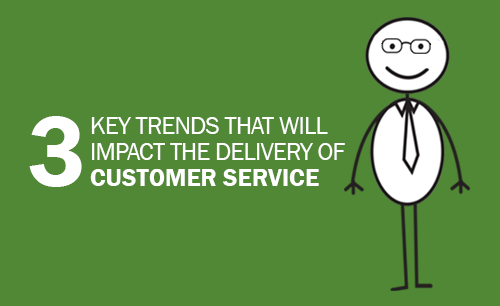3 Key trends that will impact the delivery of customer service

The quality of customer service and customer engagement delivered by a company is key to how customers view it and helps to differentiate from competitors, as Gartner points out in a recent report about customer service.
As part of this, Michael Maoz of Gartner highlights 3 key trends that will influence how customer service is delivered over the next few years:
1. The rise of self-service While nearly 60 percent of customer service interactions were completed by a human support agent in 2014, Gartner predicts this will be nearly halved over the next 24 months through the greater penetration of self-service, online communities, and automation. It stresses, however, that there will always be an important role for human interaction in customer service, advising companies to identify those customer service processes where a human support assistant can add value and enhance the customer experience.
Other industry commentators too have urged that self-service should not be taken too far. There has to be room for personalised experiences at key points in the journey. For example, customer service guru, Micah Solomon, states that savings from self-service and automation should be invested in creating meaningful human interactions. He quotes a study of the hospitality industry by J D Power which found that the number of employees with whom guests interact affects their overall satisfaction. Customers who interacted more often with service staff, and with a broader cross-section of staff were more satisfied. So while self-service in an important way of driving efficiencies, you should not forget ‘real people’ in customer service.
2. The Internet of Things By 2018, Gartner predicts that five percent of customer service cases will be initiated by web-enabled devices via the Internet of Things (IoT). This refers to the growth of sensors on ‘Things’ such as home appliances that are connected to the internet, allowing manufacturers and service organisations to remotely monitor operations, statuses, and service levels - effectively by-passing the need for consumers to request repairs or servicing.
One early application of the IoT in customer service was launched in France last year. Electrical chain Darty introduced a connected ‘panic button’ for subscribers to its support services. Customers simply press the 7cm square button and an agent will call back in less than a minute, at any time day or night. The device uses Wi-Fi or Bluetooth to communicate and is available for an initial payment and a monthly fee.
There are many examples being discussed of how customer service will be influenced by the IoT in a variety of sectors. Some of the most frequently quoted examples include the use of wearable technology to monitor patients health; connected smart-cars that ‘talk to’ the outside world; and smart meters installed in homes by utility companies to collect information that can help them provide energy saving advice.
3. Video-based chat Gartner estimates that more than 50 of the 500 largest global businesses will introduce video-based chat by 2018 for customer-facing interactions. Video-chat can provide customers with a richer sense of presence and a more personalized experience by allowing agents to see customers’ expressions and allowing on-screen sharing of supporting content such as diagrams and instructional videos.
Technically, video chat has been possible for a number of years – most PCs and mobile devices have built-in cameras and broadband/3G speeds are able to transmit high resolution moving pictures. However, while it has advantages, video has to be managed carefully. Unlike text based chat, where an agent can manage multiple conversations, with video it is only possible to complete one customer interaction at a time. And with video you also need to pay close attention to the agents’ appearance, including what they are wearing as well as the background environment (the hustle and bustle of the typical contact centre might not be conducive to making video calls).
Where video does provide a significant benefit is during the sales process, especially in a pre-sales environment, where on screen sales assistants can show and demonstrate products on-screen, allowing customers to make more informed purchase decisions.
Like Forrester’s recent predictions, Gartner’s report provides useful food for thought for customer experience and customer service teams. After all, it is only by analysing longer term trends that companies will be able to understand and apply new developments to successfully deliver value for customers in the future.






